

Quick Collection Of Bring Your Own Device (BYOD) Resources. More and more districts are realizing the power that Bring Your Own Device can have on teaching and learning.
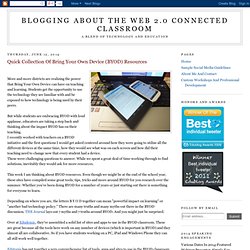
Students get the opportunity to use the technology they are familiar with and be exposed to how technology is being used by their peers. But while students are embracing BYOD with loud applause, educators are taking a step back and thinking about the impact BYOD has on their teaching. I recently worked with teachers on a BYOD initiative and the first questions I would get asked centered around how they were going to utilize all the different devices at the same time, how they would see what was on each screen and how did their teaching need to change now that every student had a device. A Comprehensive BYOD Toolkit for Schools. July 7, 2014 BYOD (Bring Your Own Device) is not only about students bringing their own devices to class and using them for educational purposes.
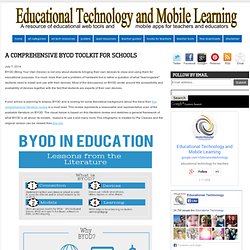
It is much more than just a problem of hardware but is rather a question of what "learningware" students need to install and use with their devices. Most of the discussions on BYOD center around the accessibility and availability of devices together with the fact that students are experts of their own devices. If your school is planning to employ BYOD and is looking for some theoretical background about this trend then this comprehensive literature review is a must read.
11 Sample Education BYOT Policies To Help You Create Your Own. We’re putting together some research for some upcoming BYOT policy content, and in the course of doing so found many existing policies enlightening.
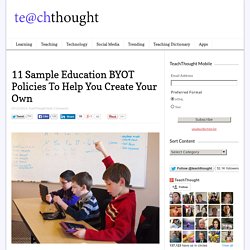
For starters, it is clear that some districts were more open-minded entering their BYOT programs than others. Many “policies” (not included below) were really more of a set of rules and consequences for breaking the rules than they were a supporting framework for teachers and students. In the end, every situation is different. There is no single “right way” to implement a BYOT program, so we’ve included 11 widely varying policy styles below, with each authoring school or district named inline. Bowling Green High School “Bring Your Own Technology” (B.Y.O.T.) Responsible Use Guidelines Purpose: Bowling Green High School uses instructional technology as one way of enhancing our mission to teach the skills, knowledge and behaviors students will need as responsible citizens in the global community.
Device Types: 11 Sample Education BYOT Policies To Help You Create Your Own. What Parents Want From Technology In The Classroom. Here’s an interesting perspective to take on technology in the classroom.
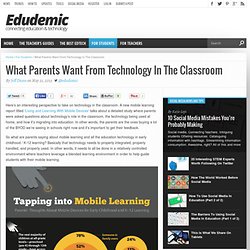
A new mobile learning report titled ‘Living and Learning With Mobile Devices‘ talks about a detailed study where parents were asked questions about technology’s role in the classroom, the technology being used at home, and how it’s migrating into education. In other words, the parents are the ones buying a lot of the BYOD we’re seeing in schools right now and it’s important to get their feedback. Internet Catalogue. The IKEA Effect of BYOT. Many of us have ordered furniture or other items from IKEA and spent a weekend assembling those products to be proudly displayed as our handiwork.

Earlier this year on National Public Radio, Shankar Vedantam, author of The Hidden Brain, reported a story in Research News entitled “Why You Love That IKEA Table, Even If It’s Crooked.” The basic premise of this research is that when we labor at something that we personally create, we value it more although it may have some imperfections. According to research by Mochon, Norton, and Ariely (2012), Building your own stuff boosts your feelings of pride and competence, and also signals to others that you are competent. This phenomenon is known as the IKEA Effect, and it has repercussions that could extend beyond the field of business marketing. As I listened to the broadcast, I reflected on the IKEA Effect’s possible implications for learning within the Bring Your Own Technology (BYOT) classroom.
Engagement Publishing. Do BYOD Programs Encourage Bullying? In theory, Bring Your Own Device (BYOD) programs in schools are a great idea; students can use their own tablets, laptops and smartphones in the classroom, and can take advantage of a wider range of apps and programs than they might be able to normally access in school.

There is a case to be made that doing so can make schools more cutting edge and capable of engaging students through methods that they're comfortable with. However, there's also a risk that BYOD could lead to bullying and inequality within schools. How, then, can BYOD be successful without causing these kinds of problems? 20 BYOD Resources For The 21st Century Schools. BYOD: What We’re Learning. Regular readers of this blog will know that our school has embraced BYOD approach to technology at school Although we have had a soft launch to thi s policy for the previous two years, this year marks the first year of our full implementation.
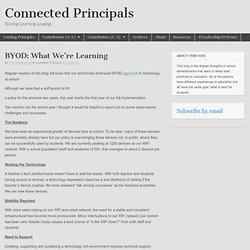
Two months into the school year I thought it would be helpful to report out on some observations, challenges and successes. The Numbers We have seen an exponential growth of devices here at school. Sharing the Technology A teacher’s tech problem/issue doesn’t have to stall the lesson. Stability Required With more users relying on our WiFi and wired network, the need for a stable and consistent infrastructural has become more pronounced.
Need to Support Creating, supporting and sustaining a technology rich environment requires technical support. Honesty & Integrity Academic Integrity is a priority. Any outlet will do Where’s the outlet? We are seeing more student devices plugged into outlets around the school. From under the desk to the desk top. Byot. Everything BYOD! The challenges of putting computers in schools and BYOD – Opinion – ABC Technology and Games. The Digital Education Revolution (DER) was supposed to make technology a ubiquitous part of the secondary learning experience by outfitting students with small, robust laptops in Year 9 and providing a school-wide wireless network.
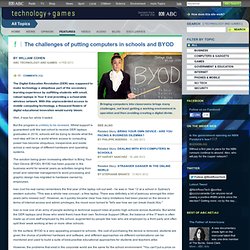
With this unprecedented access to mobile computing technology, a thousand flowers of digital educational innovation would surely bloom. Well, it was fun while it lasted. But the program is unlikely to be renewed. Whilst support is guaranteed until the last cohort to receive DER laptops graduates in 2016, schools will be trying to decide what the next step will be in a world where access to computing power has become ubiquitous, inexpensive and exists across a vast range of different hardware and operating systems.
Bring Your Own Device (BYOD) Planning for BYOD: 10 Checklists to Help Make the Move. Teachers Quick Guide to BYOD. BYOD is the catch phrase in the 2012 educational technology spheres.

10 Ways That Mobile Learning Will Revolutionize Education. Smartphones and tablet computers are radically transforming how we access our shared knowledge sources by keeping us constantly connected to near-infinite volumes of raw data and information.

We enjoy unprecedented instant access to expertise, from informal cooking lessons on YouTube to online university courses. Every day people around the globe are absorbed in exciting new forms of learning, and yet traditional schools and university systems are still struggling to leverage the many opportunities for innovation in this area. Recently frog has been researching how learning models are evolving—and how they can be improved—via the influence of mobile technologies.
We’ve found that the education industry needs new models and fresh frameworks to avoid losing touch with the radically evolving needs of its many current and potential new constituencies. We have been focusing on the concept of mLearning—where "m" usually stands for "mobile" but also just as easily for "me. " 1. 2. 3. 4. 5. 10 BYOT / BYOD Back to School Basics. Owning BYOD: Don’t Forget the PD. AUSTIN, Texas — Sept. 23, 2014 — BeckTV, one of the United States’ premier design-build systems integrators, has provided design and integration services for a network operations center (NOC) expansion that enabled KSE Media Ventures to move operations for the Outdoor Channel, acquired by the company in 2013, to the KSE Media Ventures NOC in Centennial, Colorado. Completed on budget and within just three months, the project supported a seamless transition of the popular channel from Temecula, California, to its new home without any disruption to viewers’ experience of programming, promos, and advertising.
“We’ve enjoyed a long relationship with BeckTV, and all the time we’ve spent working together is evident in the company’s understanding of our history, our philosophy, and our forward direction,” said Dave Zur, senior vice president of operations and engineering for KSE Media Ventures, as well as general manager of the KSE Media Ventures NOC. 20 BYOD Resources For The 21st Century Schools ... BYOD (Bring Your Own Device) Toolbox. The IKEA Effect of BYOT. 7 Myths About BYOD Debunked. BYOD | Viewpoint 7 Myths About BYOD Debunked Lisa Nielsen, the author of "Teaching Generation Text: Using Cell Phones to Enhance Learning" and "The Innovative Educator" blog, believes it is time to shatter a few myths about students bringing their own devices (BYOD) to school.
By Lisa Nielsen11/09/11 More than a decade into the 21st century and we are still keeping learners and teachers prisoners of the analog past by enforcing outdated mandates that ban and block them from using the digital resources of their world. Fortunately, today’s students are standing up, speaking out, and, in many cases, using the technology and websites they do not have access to in school to do so. Myth No. 1: BYOD deepens the digital divide. Myth No. 2: BYOD will result in lessons geared toward the weakest device. Do BYOD Programs Encourage Bullying? 5 Leadership Strategies for Implementing BYOT. Bring Your Own Technology (BYOT) is essentially a “bottom up” initiative in the sense that students already have personal technology devices in their pockets, and they often provide the incentive or demand to begin using those tools for instruction.
Educators usually have to scramble to catch up to students in the personal uses of technology and have to be willing to learn alongside them to facilitate BYOT effectively. This shift entails the transformation of learning experiences as students progress from solely being consumers of information to becoming producers of original content. This can be a challenging metamorphosis in many learning environments, but by utilizing some key strategies, school leaders can purposefully nurture a culture that is beneficial for transformational learning with BYOT. 1.
BYOT in Kindergarten – Engaging New Learners.